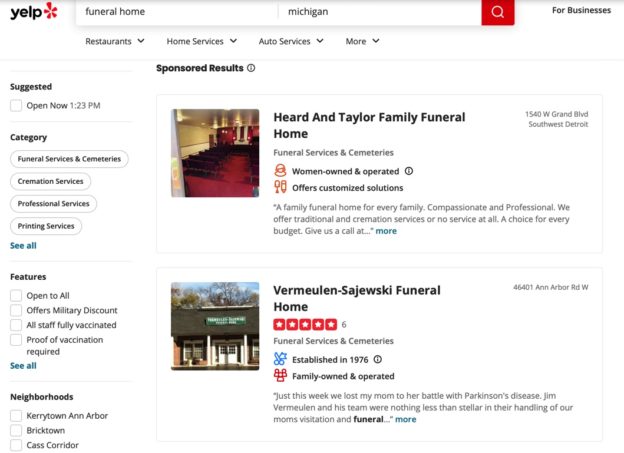Unique (And Free) Ways To Advertise Your Funeral Biz
July 25th, 2022
Advertising your funeral home, it turns out, is not our reader’s favorite pastime 🤓.
In fact, it’s far from it.
Most funeral pros feel completely clueless around funeral home advertising and marketing.
So much so, that they don’t even bother with it.
Thankfully, advertising your funeral home doesn’t have to involve a huge budget, expertise, or even ads themselves.
In fact, the best funeral home advertising isn’t advertising at all.
Check out these free ideas for advertising your funeral home that involve zero ads, and all service and collaboration:
Write guest posts for industry-related blogs
One of the best ways to get free coverage in the online world is by contributing your wisdom to it! Find death-related blogs and approach them with an idea for a guest post. Claim your expertise as a death professional. Everyone loves having guest bloggers! For the blog, it helps them to offer a wider array of content to their audience, too. So it’s a mutually beneficial idea for everyone.
Some blogs you could reach out to are:
- Our blog! (duh :-P)
- Death positive blogs
- Death Doula blogs
- Grief blogs
- Or even local news stations or podcasts
Need help starting a blog? Here’s a guide to get you started.
Get reviews from your current client families

As you can see, when you have reviews, it ranks your funeral home higher on search results.
Reviews and word-of-mouth referrals are gold in the marketing world. Why? Because consumers are more likely to trust others who have worked with your funeral home than your paid funeral home advertisements. Think about it… if you see an ad for shoes, where’s the first place you turn before you purchase them? Probably the reviews!
So get more active in asking your client families to leave you a review on Yelp or Google. This will also help your search engine results (SEO) because usually Google lists reviews on Google Business first and foremost when you search for any business online. Don’t have a Google Business page yet? Start one here. It’s free!
Want to dive deeper into the realm of reviews? Check out our blogs How to Grow Your Funeral Business With Online Reviews or How to Build Trust with Families with Online Reviews In 6 Easy Steps.
Start a blog, podcast or Youtube channel
If you’re super passionate about your work as a funeral or death professional, put some of that passion to use. In your spare time, you could write up blogs on topics people are interested in. If writing isn’t your thing, you could start-up a Youtube Channel (pretty easy) or Podcast (a bit more work) to get your expertise in the world to better serve it.
The great thing about creating fresh content on your website or Youtube is that search engine results will favor you and list you first when people search for funeral homes in your area. That’s because search engines trust websites that are regularly publishing content more than those who don’t. Starting a blog, podcast or Youtube channel doesn’t have to take a lot of time.
Here are some resources to get you started:
- How to Create a YouTube Channel for Beginners (Step-by-Step Tutorial)
- How to Start a Blog: The Complete Beginner’s Guide
- How to Start a Podcast: Everything You Need to Know to Succeed
Partner with similar businesses to your own
Collaboration breeds innovation, we all know that. But collaboration also expands your reach, audience, and gives you plenty of free marketing opportunities, too! If you don’t believe us, think about the concept of Farmers Markets. A group of farmers and local businesses collaborate together by creating an event that attracts all sorts of people. Had just one business had a fair, it would be less likely people would come in flocks. But because of the collaboration, many people are excited to come to Farmers Markets every weekend. Make sense? Good, let’s talk about some ideas for collaboration:
You can collaborate with… to create….
- Local or virtual death cafes to host your own death cafe’s
- Death Doula or Soul Midwives to have workshops or online webinars or rituals
- Hospice & Hospitals to create information fairs & Q&A forums
- Grief therapists to create offerings for your client families to support their grief journey
- Retreat Centers & Spas to offer grief retreats
- Animal Shelter to help those grieving rent a pet for a day to help with their grief
Here’s a great example of collaboration in our profession. A death deck, death expert, and industry-specific festival coming together for one event:
View this post on Instagram
We hope these ideas help you get started. For more, check out our blog: Grow Your Funeral Home Fast By Collaborating With These 6 Types of Local Businesses.
Finally, a website that advertises for you
Having a well designed, solid funeral home website like f1Connect is a game changer for your funeral home’s advertising. Learn more by scheduling a free, in-depth website consultation with one of funeralOne’s Website Success Specialists. To schedule your consultation, click here or give us a call at 800-798-2575, ext. 5!
We hope these ideas inspire you to overcome and fears or blocks you may have around funeral home advertising!


Leave a Reply